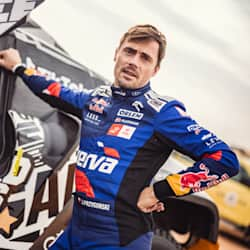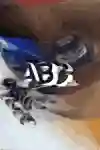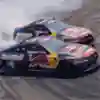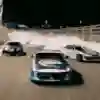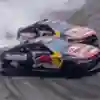Racing along, power sliding around corners on full opposite lock, with the front wheels facing away from the kerbs and smoke billowing from the rears, drifting is a spectacular test of driving skill. The sporting side of drifting in events like the Drift Masters European Championship can be complex, as can the rules. So let’s answer some of your burning questions about the sport.
01
First off, just what exactly is drifting?
Drifting is such a unique sport that it's difficult to really define it, but it's probably best described as precise car driving whilst in a controlled slide. That doesn't sound very exciting, right? However, when you realise that drifters have made a sport out of the thing that the average driver fears the most – skidding – everything looks very different. Essentially, it's all about using oversteer to get the vehicle to drive sideways through corners at high speed while the driver remains in full control of the car.
The essence of competition drifting is driving in pairs on a specifically designated route, with the goal to show the ability to perfectly control a sideways car whilst under the constant pressure of the rival.
Imagine that you're in a skid, the odometer showing about 100kph, and your visibility is almost zero because of the smoke from your tyres. The car's rear bumper is scrubbing on a concrete wall. You're literally centimetres away from the car in front of you. This is drifting on a professional level, and it's really not for the faint-hearted.
Unlike other motorsport disciplines, neither lap times nor track position plays a role in the overall score. Rather, drifting is a sport where competitors are judged on four main criteria – speed and fluidity, drift angle, line selection and style – to decide the winner of battles.
Hit play on the video below to get a better idea of what this spectacular sport is all about.

26 min
ABC of... Drifting
Drift driver Dave Egan gives the lowdown on the motorsport that's all about speed, style, smoke and skill.
02
So what is the Drift Masters European Championship?
The Drift Masters European Championship (DMEC) is the most prestigious drifting league in Europe and undoubtedly one of the top competitions in the world. Although it's now an international project, the series originated in Poland, one of the hotbeds of the sport. The Drift Masters series began in 2014, and the DMEC has stolen the hearts of fans and the best drivers on the continent thanks to events hosted in unusual locations and the high level of competition.
For 2024, the Drift Masters European Championship will be run over six rounds. Check out the full calendar below:
ROUND
DATE
COUNTRY
LOCATION
1.
May 10–12
Spain
Circuit Ricardo Tomo
2.
June 15–16
Ireland
Mondello Park
3.
July 5–6
Finland
Huvivaltio PowerPark
4.
August 2–3
Latvia
Bikernieki Circuit
5.
August 23–24
Hungary
Rabócsiring Mariapocs
6.
September 14–15
Poland
PGE Narodowy, Warsaw

44 min
Red Bull Drift Masters
Strap in for some full-throttle action as we look back on the world's most thrilling drifting event.
03
Does all that smoke score you points or not?
No way. All that billowing white smoke might look incredible from the stands and in images, but it's only a side effect of driving in a controlled oversteer at high speed. The drift itself counts for the judges, not how much your tyres pump out. We probably shouldn't call it smoke either because, technically, it's more of a mist or dust created from the friction of rubber compounds against the asphalt surface.
04
If time doesn't matter, how do drivers win a drift event?
The time of the drive and the driver's position at the finish line doesn't determine victory in drifting. It's solely the judges who determine who wins a given duel. Speed isn't totally without significance, however. A driver who covers the course as precisely as their rival, but at a visibly faster speed, will have an advantage with the judges - nothing impresses them more than driving at the limit of the laws of physics, with the throttle pressed to the floor and the brake pedal left well alone.
So, the judges are key in deciding drifting contests like the Drift Masters European Championship. They alone award points for qualifying runs, and when it's time for twin battles during the finals, they indicate who progresses to the next round.
For the 2024 season, the men with the difficult job of judging the Drift Masters European Championship events are drifting legends Kevin O'Connell, Vernon Zwaneveld and David Kalas.
05
What's the average competition drifting track like?
Unlike rallying or F1, top-level drifting doesn't need massive space or the most up-to-date facility to deliver thrills. The length of drift tracks doesn't usually exceed one kilometre. Thanks to this, drift competitions aren't bound to traditional track racing settings, but can be taken into places such as stadiums or simple car parks.
Naturally, longer tracks are conducive to higher speeds, like the renowned Biekierniki track in Riga, Latvia, which DMEC will visit on July 29–30. On the other hand, slower courses make it easier for drivers to extremely close during twin battles. Hardware differences are less visible at lower speeds, and drivers don't need such a large margin of safety and so drive closer to each other. This will undoubtedly be the case during the final round of the season inside PGE Narodowy national football stadium in Warsaw, Poland.
The actual courses used in DMEC events and drifting, in general, are always preceded by a run-up, where drivers accelerate their cars up to speed. Then, the drift zone begins with a transverse line marked on the asphalt and from this clearly marked point to the finish line, the cars must be oversteering at all times. Simply driving sideways isn't enough, however. Drivers also need to follow the right line, which is clearly indicated by the judges before the event.
How are the drivers supposed to know when and where to be on the track to meet the judges' criteria? That's where internal and external zones and clipping points (called simply clips) come in. Zones are areas painted on the asphalt (often helpfully marked with posts outside the track) that the driver is supposed to hit with their car.
As the name suggests, the inner zones are located on the inside of the turn and are generally smaller. They're often a square shape, and the drifter must enter them with the front of the car. The outer ones are located outside the arch and are usually much longer - sometimes up to several dozen metres long. Their outer border is also often marked by concrete.
Clips have a very similar role to interior zones, but they're vertical pillars to which the driver must get as close as possible to the front of the car.
06
What's the purpose of braking zones?
Judges want the drivers to drive spectacularly and create conditions for even duels. That's why holding the throttle to the floor is like breathing for the best drifters. However, there are places on the track where it's difficult to floor it in close formation without first pressing the brake just a bit. Therefore, the judges designate braking zones, where speed reduction isn't considered a fault.
Outside of those specific spots, braking is a big no-no and a points killer. For example, if the competitor in front clearly brakes beyond the designated zone and the chasing rival can't avoid a collision, the judges will generally blame the leading driver.
07
Is that why drift cars have brake lights front and rear?
Exactly. Watching the competition, you'll certainly notice the red LED strips above the front and rear windscreens of the cars, and that's so that the judges can easily see when a driver applies the brakes. A similar role is played by a single spoke on the rims painted in a distinctive colour, which allows judges to assess whether the wheel is moving or has been stopped by the brakes.
08
How do drivers qualify for Drift Masters European Championship races?
The line of a perfect pass, i.e. one in which the driver drifts through all the zones fully, is called the qualifying line, and this is a reference point for every driver.
In the Drift Masters qualifiers, drivers compete alone, and for this one drive, they can earn up to 100 points. The most points can be won for the passing line – up to 60 points. For the angle of the car in the drifts, the judges award up to 20 points, and the other 20 points can be gained from driving style. This consists of three elements: the appearance of initiation, i.e. starting the drift section (five points), the smoothness of the ride (10 points) and commitment (five points).
During qualification for the Drift Masters European Championship events, each driver has two runs on course, and their best score counts towards the classification, with only the 32 top competitors making it through to the finals and the twin battles.
In the Top 32 round, the first qualifier meets the 32nd qualifier and so on. Only the results of the head-to-head battles decide who goes through, and at each stage, the number of participants is halved until the Top 4 round, where the two finalists are selected, and the two losers go on to clash for third place in the small final. During one event, a driver can take part in a maximum of five duels (not counting overtime).
09
What's the difference between a lead run and chase run?
The essence of drifting is the direct skirmishes in pairs, and the duel always consists of two runs, so that both participants have a chance to show themselves leading and chasing. This is the key principle of the sport.
The driver with the highest qualifying position drives what's known as the lead run first. The idea is that they recreate the perfect qualifying run as closely as possible, driving an optimal line aggressively, smoothly and at a big drift angle. They must not hinder the chaser, otherwise, the judges will take this into account when assessing the performance. After the first run, the roles are then swapped.
In the chase run spot, a driver's main task is to imitate the movements of a fleeing opponent as perfectly and closely as possible. Essentially, they're supposed to be a shadow, and even slight contact between the cars is acceptable – highly desirable, actually. However, if the chaser cuts the angle of their drift or cuts corners to keep up with their rival, their score will be lower.
10
How are twin battle winners decided?
After both runs are completed, the judges assess who's shown more control over their car overall. The driver that they judge performed better wins the duel and moves on. Very fine details often determine the result. For example, both drivers may have driven equally perfect lead runs, but if one was a little closer to his opponent during their chase run, they'll move on. As you can see, the rules of drifting are quite complicated, but tune in to the Drift Masters European Championships broadcasts on Red Bull TV, and you'll soon pick up the nuances of the sport.
11
Is there such a thing as overtime in drifitng?
There is actually, and the higher the level of competition, the more often overtime occurs. When two great drivers meet, it's very difficult for the judges to find a mistake that will decide the result, so if after two regular runs the winner can't be determined, the duel takes place again. In Drift Masters, only one overtime per pair is allowed, and the judges must then indicate the winner.
12
What do I need to know about null errors?
Drifting judges can catch even the very smallest mistakes, but there are some mistakes that even the most untrained eye can spot – the really big, obvious ones. These are known as null errors, resulting in the deduction of all a driver's points for that run. Null errors include such mistakes as losing the drift, a car's two wheels leaving the track or a spin.
13
And what's a bye run?
Sometimes only one driver manages to make the start line of the duel due to situations like mechanical issues. In this situation, the race-ready competitor automatically moves on to the next round and takes a bye run, which is essentially a show run that gives them invaluable free track time.
14
Can we expect some spectacular smashes?
Oh yes! We're talking about a sport in which two cars with around 1,000bhp slide side-by-side at speeds of up to 150kph, so of course, there's frequent contact during duels. Due to the relatively low speed in motorsport terms, however, contact between drivers usually ends with only light scratches. There is the occasional massive shunt, though, especially on the faster tracks and those lined by concrete walls. Professional drifting cars are equipped with a full cache of safety features, however, so the majority of accidents seem more serious than they really are.
15
Who should we look out for in the Drift Masters European Championship?
Who you should get behind depends on which driver's style gets you the most excited, and if you don't have a favourite driver yet, you will after watching a few Drift Masters European Championship races.
In terms of nations, Poland and Ireland have been the two strongest countries on the European drifting scene for years, and you can guarantee drivers from both countries will be at the front during this year's series. Pole Piotr Więcek is currently the best drifter in Europe and is famous for his perfect and extremely fast runs, while the Irish won last year's Drift Masters nation classification, led by James Deane and brothers Jack and Conor Shanahan. It is also worth watching the performances of such drivers as Adam Zalewski, Paweł Korpuliński and Kuba Przygoński.
16
Whats makes drift cars special?
Compared to other motorsports, drifting has exceptionally liberal technical regulations, and thanks to this, far-reaching car modifications are possible. Transplanting engines from other cars, converting front-wheel drive cars into rear-wheel drive cars, and more are common mods. And this mod-heavy approach is one of the things that attracts many fans to drifting.
When it comes to security issues, everyone takes things very seriously, with roll cages, bucket seats with five-point harnesses, safety-certified overalls and helmets, and a fire extinguisher system all required.
Series such as the Drift Masters European Championship don't limit the power of the cars either, so it's not uncommon to see engines with four-digit numbers working under the hoods of some vehicles. 600bhp is probably the absolute minimum power a driver needs to be in the game for top positions.
It also goes without saying that drifting engines have little to do with the original product. Virtually everything is replaced or tuned in them, from injectors to pistons and connecting rods. It's also pretty much vital to add a turbocharger to a drifting engine, and many designers additionally install a nitrous oxide injection system for instant power boosts.
17
What does the abbreviation 2JZ stand for?
Every fan of drifting, sooner or later, must learn this three-character abbreviation. It's not some magic fuel ingredient, nor is it the nickname of some drifting god. This is the designation of the engine that's probably the most-used drive unit in the drifting world. We are talking about a six-cylinder, three-litre engine developed by Toyota and associated primarily with the fourth-generation Supra model. The unit is famous for its exceptional durability and success with tuning, so it's no wonder it's the most sought-after engine in the sport.
18
What tyres do Drift Masters drivers use?
The main tyre partner of the Drift Masters European Championship is the Japanese company Valino, which specialises in the production of drift tyres. Their products are used by current DMEC champion Piotr Więcek among others.
Unlike WRC or F1, however, in Drift Masters drivers aren't limited to tyres from a specific manufacturer. Certain parameters are fixed, though, and one of the most important is tyre width, which must not be more than 285mm at the rear.
Given the smoke DMEC drivers produce from their tyres, you could be forgiven for thinking they use the slickest rubber. Actually, they're extremely sticky. If they weren't, a 1,000bhp drift car wouldn't even get off the start line. Nobody gets the most out of a car's power if its tires don't have good contact with the ground.
Part of this story







